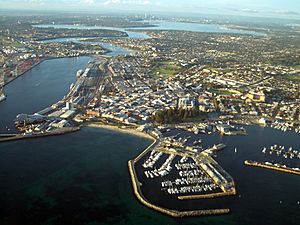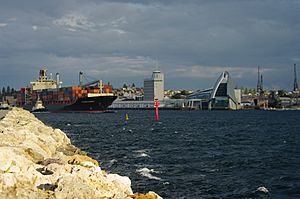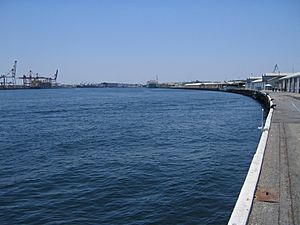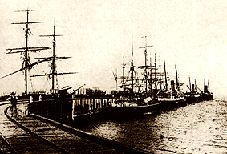Fremantle Harbour facts for kids
Quick facts for kids Fremantle Harbour |
|
|---|---|
 |
|
| Lua error in Module:Location_map at line 530: Unable to find the specified location map definition: "Module:Location map/data/yes" does not exist. | |
| Location | |
| Country | Australia |
| Location | Fremantle, Western Australia |
| Coordinates | 32°03′S 115°44′E / 32.050°S 115.733°E |
| Details | |
| Available berths | 12 |
| Draft depth | 14.5 m |



Fremantle Harbour is Western Australia's biggest and busiest port for general cargo. It is also a very important historical place. The inner harbour handles many sea containers, imported vehicles, and exported animals. It also welcomes cruise ships and navy ships. The port operates 24 hours a day and is located right next to the city of Fremantle.
Fremantle Harbour has two main parts: the Inner Harbour and the Outer Harbour. The Inner Harbour is at the mouth of the Swan River. The Outer Harbour is about 20 kilometres south at Kwinana. It handles large amounts of bulk goods like grain, oil, and minerals. Gage Roads is another important area. It is where ships can anchor between Rottnest Island and the mainland. The Inner Harbour has two main docks called North Quay and Victoria Quay. All these areas are managed by Fremantle Port Authority, which is a government business.
Contents
History of Fremantle Harbour
Fremantle became a port as soon as the Swan River Colony was started in 1829. However, the entrance to the Swan River was blocked by a rocky bar. This made it very hard for large ships to enter. The first steamship to get into the port was HMS Driver on December 4, 1845.

Before the harbour was built, ships used the Long Jetty. This long pier stretched out into the open sea near Bathers Beach. Cargo was unloaded onto the jetty. Then it was taken by rail or loaded onto barges that sailed up the river. Sailors did not like using the Long Jetty because it was difficult.
Building the Harbour
British engineer John Coode first suggested building an outer harbour. He thought building a port in the river mouth would always get blocked by sand. But by 1891, Charles Yelverton O'Connor became the Colony's Engineer-in-Chief. He decided the best idea was to build an inner harbour right in the mouth of the Swan River.
The discovery of gold in Western Australia meant a working port was needed very quickly. After much discussion, the government agreed to O'Connor's plan. Money was raised in London, and work began in late 1892.
The first part of the harbour work began with a special ceremony. The Governor's wife, Lady Robinson, tipped the first load of rocks for the North Mole. Workers used blasting and dredging to create a deep channel. They also built two moles (long walls) to protect the harbour entrance. Land was also created to build quays (docks) and warehouses.
The inner harbour officially opened on May 4, 1897. The steamer Sultan was the first ship to enter the partly built port. Even today, the basic shape of the Inner Harbour is the same. This shows how smart and brave its designer, O'Connor, was.
There are two lighthouses at the harbour entrance. The green South Mole Lighthouse started working in 1903. The red North Mole Lighthouse started in 1906.
Mail Ships and Rail Links
As the port was finished, the government worked to make Fremantle a stop for mail ships. Other Australian states wanted Albany to stay the main mail port. But on August 3, 1900, Fremantle won. The RMS Ormuz was the first British mail ship to arrive at Fremantle Harbour. By 1901, Fremantle had more ships and cargo than Albany.
The railway to the harbour was built in the 1880s. It continued to grow with workshops, sheds, and train yards. In 1907, Fremantle railway station opened.
Wartime Role
During World War II, many Allied navy ships used Fremantle Harbour. Battleships, troop transports, and hospital ships all visited. Large passenger ships like RMS Queen Elizabeth and RMS Queen Mary also came. They were too big for the inner harbour, so they anchored in Gage Roads.
In 1940, special barriers were put in the harbour for security. Anti-aircraft guns were also built. By 1941, an anti-submarine system was installed between Swanbourne and Rottnest Island. This system warned if any ships passed over it. The outer harbour also had a large anti-submarine net.
After the fall of Singapore in 1942, many ships came to Fremantle for safety. Sometimes, 30 ships were anchored in Gage Roads at once. The inner harbour was so busy that up to four large ships would be tied up together. In just two weeks in March 1942, 103 navy and merchant ships arrived.
Fremantle Submarine Base became the biggest submarine base in the southern hemisphere during World War II. The first United States submarines arrived in 1942. The US Navy built a submarine repair place on North Quay. Until 1945, the port hosted over 170 submarines from the U.S., British, and Dutch navies.
Container Terminal
On March 28, 1969, the first container ship to arrive in Australia, the Encounter Bay, docked at Fremantle's new container terminal. The terminal was officially opened the next day. This expansion project started in 1965. By 1970, Fremantle Port had handled 50,000 containers.
Victoria Quay

A statue honoring C. Y. O'Connor was put up on Victoria Quay in 1911. It is now near the entrance to the Fremantle Ports building.
On May 4, 1919, during a clash between police and workers, a worker named Tom Edwards was hurt. He died three days later. A memorial fountain was built in his memory that year.
The Fremantle Passenger Terminal was built for the 1962 British Empire and Commonwealth Games.
North Quay
North Quay is the part of Fremantle Harbour on the northern side of the Swan River. It was built in the late 1890s. Today, this area is mainly used for container shipping. On its western side is Rous Head, a smaller harbour for ship repairs. It also has one of the ferry terminals for Rottnest Island.
Gage Roads
Gage Roads is a shipping lane and anchorage for ships going to Fremantle port. It is a wide area of water where ships can wait safely. The bottom of Gage Roads is covered by seagrass.
Outer Harbour and Cockburn Sound
The Outer Harbour is south of the Inner Harbour. It includes a deep water channel and several smaller channels. These channels are used for shipping.
Cockburn Sound
Cockburn Sound is a large inlet that stretches for about 25 kilometres. It is bounded by the mainland on the east and Garden Island on the west.
Fremantle Outer Harbour Facilities
The Fremantle Outer Harbour has several jetties. These include the Alcoa Jetty, the Kwinana Bulk Terminal, the BP Oil Refinery Jetty, the Kwinana Bulk Jetty, and the CBH Grain Jetty.
Fremantle Ports operates the Kwinana Bulk Terminal and the Kwinana Bulk Jetty. These are used for importing and exporting large amounts of goods. These goods include iron ore, coal, cement, and oil. The other three facilities are run by private companies. The Outer Harbour facilities at Kwinana were first built in 1955. They grew quickly in the 1960s and 1970s.
Signalling Equipment
In 1928, the Signal Station at Fremantle moved to Cantonment Hill. In 1964, a new signal station opened on the Port Authority building.
South Mole
The South Mole is a breakwater built in the 1890s. It helps keep ships safe in the Inner Harbour. A lighthouse was added in 1903. It first shone a white light, but this was changed to a green light.
North Mole
The North Mole was also built in the 1890s. It has been made longer several times. The most recent extension was in the late 1980s. This was to add an entrance to the Rous Head harbour. At the end of the mole is the North Mole Lighthouse. It used to shine a green light, but this was changed to red.
Engineering Heritage
Fremantle Harbour is recognized as a National Engineering Landmark. This is part of the Engineering Heritage Recognition Program by Engineers Australia.
Images for kids
-
A container ship leaving the port. The tall building at the centre are the port's administration offices and the Western Australian Maritime Museum is to the right.
-
View north-east along Victoria Quay.
-
HMS Renown at "A" Shed, Victoria Quay, May 1927.
-
The one kilometre long Long Jetty was the main port until the harbour opened in 1897.
-
C. Y. O'Connor statue at the entrance to Fremantle Port.












